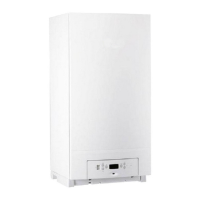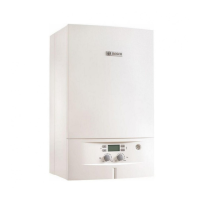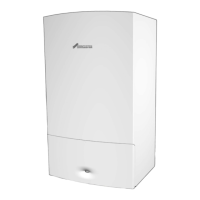Regulations
Condens 7000 FP – 6721846699 (2022/12)
10
3Regulations
DANGER
Failure to comply with instructions may result in material damage
and personal injury, including danger to life!
Comply with all instructions.
NOTICE
System damage due to differing operating conditions!
Faults may arise when deviating from the specified operating operating
conditions. Individual components or the boiler may be destroyed if
there are deviations.
Observe the binding information on the data plate.
3.1 Regulations
In order to ensure installation and operation of the product in
accordance with the regulations, please observe all the applicable
national and regional regulations as well as all technical rules and
guidelines.
The document 6720807972 contains information about the applicable
regulations. You can use the document search on our website to display
this. You will find the address of the website on the back of these
instructions.
3.2 Duty to obtain a permit and provide notification
Prior to installation of the heating and flue system:
Inform relevant building authority.
If required by the Clean Air Act 1993, seek approval for the flue
system from the Local Authority. For additional guidance see IGE/UP/
10 edition 4.
Make sure that there are no concerns on the part of the authority
regarding the planned installation
Make sure that official requirements are complied with.
Please note that in certain regions approvals may be required for the
flue system and the connection of the condensate outlet to the public
sewerage system.
3.3 Validity of regulations
Modified regulations or supplements are also valid at the time of
installation and must be observed.
3.4 Notes on installation and operation
Use only genuine spare parts from the manufacturer. The manufacturer
can assume no liability for damage caused by spare parts not supplied by
the manufacturer.
When installing and operating the heating system, observe the following
requirements:
• The local building regulations regarding installation conditions.
• The local building regulations regarding the supply and exhaust air
systems, and the chimney connection.
• Latest edition of the IEE Wiring regulations governing electrical
connection to the mains power supply
• Regulations and standards regarding the safety equipment in water-
filled heating systems. For guidance see the ICOM water treatment
guide for commercial heating systems.
• Make sure that the regional approvals required for the flue system
and condensate connection to the public sewage system have been
obtained.
3.5 Installation location
DANGER
Danger to life from explosion!
An increased and permanent ammonia concentration may lead to stress
corrosion cracking on brass (e.g.gas valves, union nuts). As a result,
there is a risk of explosion from gas escaping.
Do not use wall mounted gas boilers in rooms where there is an
increased or permanent ammoniac concentration (e.g. livestock
stables or storage room for fertilisers).
If contact with ammonia is unavoidable, make sure that there are no
brass parts installed in the system.
DANGER
Risk of fire through flammable materials or liquids.
Never store flammable materials or liquids in the immediate vicinity
of the boiler.
NOTICE
Frost damage!
Install the heating system in a frost-free room.
NOTICE
Boiler damage through contaminated combustion air or
contaminated air in the vicinity of the boiler!
Never operate the boiler under dusty conditions or where the
atmosphere is contaminated with corrosive substances. These might
be, for example, paint shops, hairdressing salons and agricultural
operations involving the production of manure.
Never operate boilers in locations where trichloroethene,
halogenated hydrocarbons or other corrosive chemical substances
are used or stored. Certain adhesives, solvents, cleaning agents and
paints, for example, contain these substances.
Choose or prepare a suitable installation location.
NOTICE
The boiler may only be operated up to a maximum installation
altitude of 1200 m above sea level!
Table 20 (technical data), see 68.
NOTICE
The boiler may be operated with combustion air up to a certain
maximum temperature!
The maximum temperature of the combustion air must not exceed 35 °C.
Table 20 (technical data), see 68.

